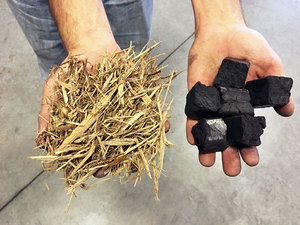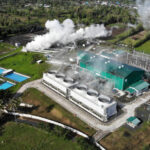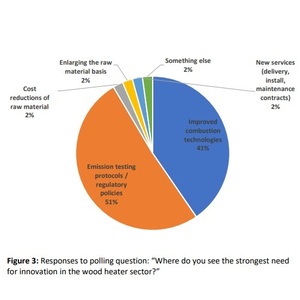Biocoal Exports’ Potential Role in US Forest Restoration and Japan’s Decarbonization Efforts
Energy Disrupter
<img src="https://biomassmagazine.com/uploads/posts/magazine/2022/10/resize/Cont2-Biocoal_16656012609883-300×300-noup.jpg" title="Juniper before and after being converted to biocoal via HM3 Energy’s torrefaction process.
PHOTO: HM3 Energy </small>”>
<img src="https://biomassmagazine.com/uploads/posts/magazine/2022/10/resize/Prescott-National-Forest_16656012610676-300×300-noup.jpg" title="As is the case with wildfires, prescribed pile burns like this one in Prescott National Forest can emit hazardous, fine particulate matter into the atmosphere.
</small>”>
ADVERTISEMENT
Japan’s reliance on fossil-based sources such as oil, coal and natural gas for electricity production has increased significantly since the 2011 Fukushima nuclear disaster. To reduce this heavy reliance on nonrenewable, fossil-based energy, Japan’s interest in nonnuclear renewable energy, especially biomass-based energy, has grown tremendously over the years. Japan’s national commitment for decarbonizing its electricity grid is evident from former Prime Minister Yoshihide Suga’s announcement in 2021 that Japan would reduce its greenhouse gas emissions to net zero by 2050. As an immediate effort, Japan also mandated shuttering some 100 inefficient coal plants as soon as 2030. Minister Suga said Japan would “ …maximize the use of renewables and other noncarbon power sources …”
Despite current Prime Minister Fumio Kishida’s announcement of restarting many idled nuclear plants due to rising energy costs, Japanese utilities will still need coal replacement fuel to lengthen the lifespans of their high-efficiency coal plants. Also, many industrial coal boiler operators need coal replacement fuel soon, or they may be shut down. Torrefied wood pellets, also known as biocoal, is an excellent coal replacement alternative given its chemical and physical properties are closer to coal. With biocoal’s superior gridability attributes and higher energy density, a significant proportion (50% or more) of torrefied pellets could be used for cofiring without major modifications to the existing coal-powered thermal plants. Finally, with biocoal’s comparable shipping and handling attributes to that of bituminous coal, it has attracted increasing interest as coal replacement fuel.
Idemitsu Kosan Co. Ltd., one of Japan’s three major coal importers, with combined domestic and overseas coal sales of 20 million metric tons (MT) per year, has the goal of importing 3 million MT of biocoal by 2030 to meet initial market demand for carbon-neutral fuel. The development of the biocoal market is under review in Japan by major utilities, coal importers and Japanese government policymakers. Is there enough independently certified, sustainably available fiber around the world to produce the biocoal at a reasonable cost per metric ton? Additionally, because biocoal production requires much higher heat than white pellet production, does that negatively impact the carbon life cycle analysis for biocoal as a good alternative to coal?
The following is a strategy of how western U.S. forests could profitably produce a major portion of Japan’s need for biocoal over the coming years.
Long-Term, Sustainably Available Biomass
Over 100 years of suppression of all fires, including natural, low-intensity fires, has resulted in many unnaturally dense forests in the western U.S., which are at risk of severe wildfire. The U.S. Forest Service has forest restoration treatments underway, such as thinning, brush clearing and prescribed burning on 80 million acres of its own land, mostly in the West. California alone is targeting the treatment of 1 million acres annually by 2025 to scale up forest thinning and prescribed fire efforts. These treatments are meant to “reduce long-term greenhouse gas emissions and harmful air pollution from large and catastrophic wildfires,” according to the Wildfire and Forest Resilience Action Plan produced by California’s Forest Management Task Force.
The amount of thinning work underway or planned in California and several other western states will produce copious amounts of biomass, much of which has no market and is therefore burned in piles. As is the case with wildfires, these pile burns can emit hazardous, fine particulate matter into the atmosphere, measuring 2.5 microns or less in width (PM2.5). This has become a growing concern in the western rural areas where pile burns regularly take place. They are also costly and time consuming to perform, costing $1,500 or more per acre.
Selective Forest Thinning and Increased Carbon Storage
More and more research has shown that selectively thinning overstocked forests has multiple benefits. “In a warming climate, thinning reduces competition for water, allowing trees to grow faster, store more carbon and be more resilient to drought and pests,” according to Our Burning Challenge: Restore our Forests, a publication by the Nature Conservancy in Arizona. “Scientific and professional firefighting evidence shows that where thinning is completed before wildfires, fire severity is reduced, and in some cases, damage to communities is averted.”
Biomass Residual-Based Biocoal
HM3 Energy Inc., a biocoal technology provider, developed its torrefaction technology using biomass residuals left after logging and thinning operations, rather than clean wood chips produced from whole logs. This focus on using forest waste in its demonstration plant test runs helped it win a U.S. Forest Service Wood Innovations Grant in 2019.
The grant work provided budgetary design work to determine construction costs for a 50,000-metric-ton-per-year (MTPY) biocoal plant in northern Arizona. Northern Arizona University’s Ecological Restoration Institute performed studies on sustainable biomass availability and shipping logistics, while Coconino County helped identify good sites for a production facility that could eventually produce up to 100,000 MTPY, with access to the BNSF Railroad for exporting the biocoal to a port in California and on to Japan.
The grant work determined that there would be enough sustainably available biomass from ponderosa pine and juniper harvesting and thinning operations for at least a 20-year period within reasonable hauling distances of several potential sites in northern Arizona. Federal forests in Northern Arizona have plans to thin 1.5 million acres over the next 20 years. With targeted retention at only 50 trees per acre, this will result in 2.25 million tons of forest slash per year that could be turned into biocoal.
The biocoal would be shipped just like coal, in open hopper rail cars, to the Port of Stockton. From there, it would be exported to a Japanese power plant, typically situated right on the coast with its own port, where it would be stored without cover, just like coal.
As part of the grant work, HM3 Energy compared the costs of using white pellets versus biocoal produced using HM3’s technology as coal replacement fuel in Japan. The higher production cost of biocoal was greatly mitigated by the much lower shipping and handling costs. In addition, coal plants would not have to perform costly modifications to use white pellets, such as building silos for storage or separate feeding systems that can handle the fibrous pellets. When combusted, white pellets do not produce the same steam temperature as biocoal does, resulting in boiler inefficiencies.
Overall, HM3’s grant work in 2021 determined that a 100,000 MTPY plant using its technology in northern Arizona could deliver biocoal to the Japanese coal burner tip for $11.58 cents per gigajoule, compared to a cost of $13.15 for white pellets.
Carbon Life Cycle Analysis
The University of Washington School of Environmental and Forest Sciences performed a series of comprehensive life cycle assessment (LCA) of biocoal and documented the environmental footprint, from cradle to grave, of extracting biomass and converting it to biofuel alternatives. Emissions from feedstock extraction and transportation to the manufacturing facility, processing, transportation of the pellets to a shipping port (in Washington or Oregon), as well as ocean transportation to a port in Japan were all included. Local pollution, as well as impacts on air quality, water and soil were also considered. The total LCA of electricity production from residual biomass-based wood pellets in a bioenergy plant in Japan was then compared to that of electricity production from coal.
The research concluded that pellets produced from residues, on average, produce 90% fewer greenhouse gas emissions compared to coal. The assessment noted that biomass burned in a controlled environment, such as a bioenergy facility, emits 95% fewer pollutants to the atmosphere as compared to open biomass burns, such as prescribed burns or wildfires. “After factoring in all the particulate matter, emissions of harvesting, processing, local and international transportation, harvest slash-based pellets reduce PM2.5 by 88%, with most of this clean air benefit going to local communities.” The research further concluded that the marginally higher carbon impact associated with the production of torrefied pellets (biocoal) is mitigated by their energy efficient long-distance transportation.
Conclusion
The western U.S. has, and will continue to have for some years to come, a large amount of sustainably available biomass from thinning and harvesting operations. Forest thinning operations are planned for millions of acres to mitigate the risk of unnaturally severe wildfires and restore the health of forests so they better absorb and store carbon. Using biomass residuals for biocoal production will help reduce management costs and result in fewer pile burns, improving air quality and reducing carbon emissions. In many cases, particularly from the western states, biocoal can be economically exported to Japan to replace coal and greatly reduce its carbon footprint.
Author: Hiroshi Morihara
CEO, HM3 Energy Inc.
[email protected]
www.hme3.com
















